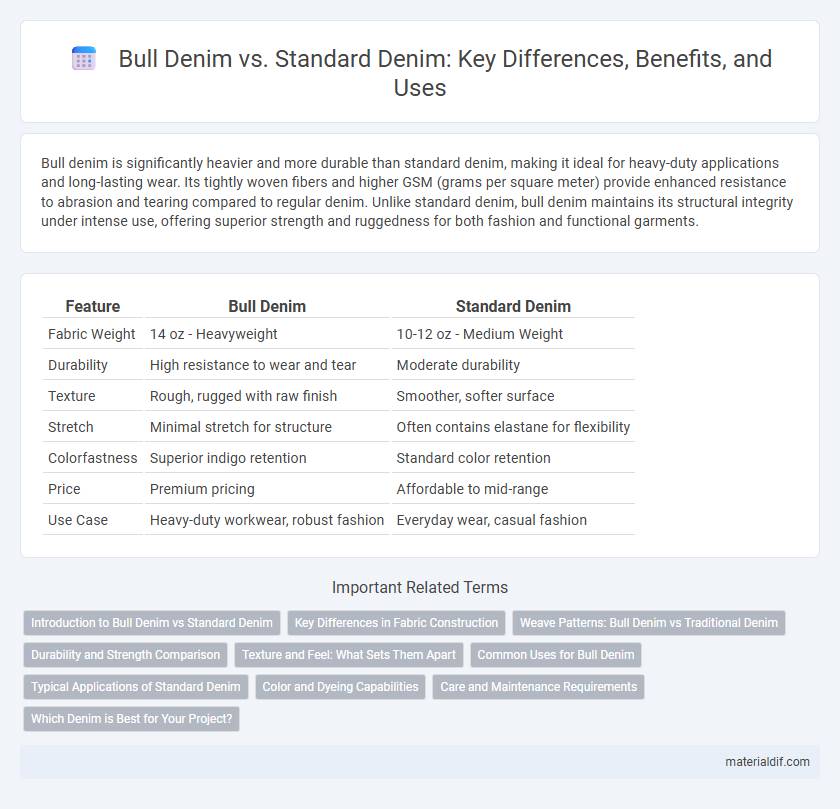Bull denim is significantly heavier and more durable than standard denim, making it ideal for heavy-duty applications and long-lasting wear. Its tightly woven fibers and higher GSM (grams per square meter) provide enhanced resistance to abrasion and tearing compared to regular denim. Unlike standard denim, bull denim maintains its structural integrity under intense use, offering superior strength and ruggedness for both fashion and functional garments.
Table of Comparison
| Feature | Bull Denim | Standard Denim |
|---|---|---|
| Fabric Weight | 14 oz - Heavyweight | 10-12 oz - Medium Weight |
| Durability | High resistance to wear and tear | Moderate durability |
| Texture | Rough, rugged with raw finish | Smoother, softer surface |
| Stretch | Minimal stretch for structure | Often contains elastane for flexibility |
| Colorfastness | Superior indigo retention | Standard color retention |
| Price | Premium pricing | Affordable to mid-range |
| Use Case | Heavy-duty workwear, robust fashion | Everyday wear, casual fashion |
Introduction to Bull Denim vs Standard Denim
Bull denim features a heavier weight fabric, typically woven with thicker yarns, offering enhanced durability compared to standard denim. Standard denim, commonly made from medium-weight cotton twill, prioritizes comfort and flexibility but may wear out faster under heavy use. The unique construction of bull denim makes it ideal for rugged workwear and outdoor activities requiring robust material performance.
Key Differences in Fabric Construction
Bull denim features a tighter weave pattern and higher thread count compared to standard denim, resulting in increased durability and a smoother texture. Its fabric is typically heavier, made with premium cotton fibers that enhance tensile strength and resistance to wear. Standard denim often uses a looser weave and lighter weight yarns, which provide more flexibility but less longevity than bull denim.
Weave Patterns: Bull Denim vs Traditional Denim
Bull denim features a distinctive basket weave pattern, offering enhanced durability and a textured surface compared to traditional denim's classic twill weave, which creates the familiar diagonal ribbing. The basket weave in Bull denim interlaces multiple yarns per pass, resulting in a heavier, more robust fabric ideal for heavy-duty use. Traditional denim's twill weave allows for greater flexibility and softness, making it the preferred choice for everyday wear.
Durability and Strength Comparison
Bull denim outperforms standard denim in durability due to its heavyweight fabric, typically woven with a tighter weave and higher thread count, which enhances resistance to wear and tear. The fibers in Bull denim are often treated or reinforced, providing superior tensile strength and preventing fabric stretching or tearing under heavy use. This makes Bull denim ideal for rugged applications and prolonged wear compared to the more common and lighter standard denim varieties.
Texture and Feel: What Sets Them Apart
Bull denim features a densely woven texture that provides exceptional durability and a rugged feel, distinguishing it from standard denim's softer, more flexible fabric. The heavier weight and tighter weave of Bull denim create a coarse surface that enhances resistance to wear and tear. In contrast, standard denim typically offers a smoother, more breathable texture suited for everyday comfort.
Common Uses for Bull Denim
Bull denim, known for its heavier weight and reinforced weave, is commonly used in workwear, upholstery, and heavy-duty outdoor gear due to its exceptional durability and resistance to abrasion. Unlike standard denim, which is typically utilized for casual clothing like jeans and jackets, bull denim's robust construction makes it ideal for industrial gloves, protective aprons, and rugged footwear. Its thickness and toughness provide enhanced protection and longevity in demanding environments where standard denim would wear out quickly.
Typical Applications of Standard Denim
Standard denim is widely used in the fashion industry for producing jeans, jackets, and skirts due to its durability and classic appearance. It is commonly utilized in casual wear, workwear, and accessories like bags and hats, offering versatility across various clothing styles. The fabric's balance of strength and comfort makes it ideal for everyday apparel and lifestyle products, meeting consumer demands for both functionality and style.
Color and Dyeing Capabilities
Bull denim exhibits superior color retention and dyeing capabilities compared to standard denim, thanks to its advanced pigment infusion technology. The fabric absorbs dyes more evenly, resulting in richer, deeper hues that maintain vibrancy through multiple washes. Enhanced colorfastness and dye uniformity make Bull denim a preferred choice for premium denim collections.
Care and Maintenance Requirements
Bull denim requires less frequent washing due to its higher durability and resistance to fading compared to standard denim, which tends to lose color and fabric integrity faster. Its dense weave and robust construction make Bull denim more resilient against wear and tear, reducing the need for intensive care routines. Standard denim demands more careful washing practices, such as cold water cycles and air drying, to preserve its color and longevity.
Which Denim is Best for Your Project?
Bull denim offers superior durability and a heavier weight compared to standard denim, making it ideal for projects requiring long-lasting strength such as workwear or heavy-duty upholstery. Standard denim provides greater flexibility and breathability, suited for casual apparel and fashion-forward designs. Choosing the best denim depends on your project's need for toughness versus comfort and style.
Bull denim vs standard denim Infographic

 materialdif.com
materialdif.com